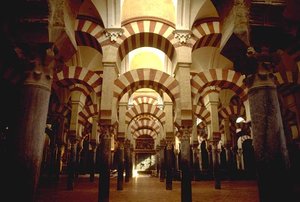Mezquita
|
|
Mezquita, (from Arabic "Masjid"), is Spanish for "mosque".
This article deals with the one in Cordoba, Spain. It is a 10th century Moorish Islamic house of prayer. The site is older than the building, having been host to a Roman pagan temple, the cathedral church of St Vincent of Saragossa built by the Catholic bishops under Visigothic rule, and finally the Mezquita itself. Within is a Renaissance cathedral, built by the Christian conquerors in the early 13th century.
The construction of the Mezquita lasted for over two centuries, starting in 784 A.D. under the supervision of the emir of Cordoba, Abd ar-Rahman I. The Mosque underwent numerous subsequent changes: Abd ar-Rahman III ordered a new minaret, while Al-Hakam II, in 961, enlarged the plan of the building and enriched the mihrab. The last of the reforms was carried out by Al-Mansur Ibn Abi Aamir in 987. It was the most magnificent of the more than 1,000 mosques in the city. The city in which it was built was subject to frequent invasion, and each conquering wave added their own mark to the architecture. The building is most notable for its giant arches, with over 1,000 columns of jasper, onyx, marble, and granite. These were made from pieces of the Roman temple which had occupied the site previously, as well as other destroyed Roman buildings. Besides the horseshoe-topped arches, the Mezquita also features richly gilded prayer niches. It reached its current dimensions in 987 with the completion of the outer naves and orange tree courtyard.
Mesquite.jpg
The very year (1236) that Cordoba was recaptured from the Moors, by King Ferdinand III of Castile and rejoined Christendom, the mosque was reconsecrated a Christian church. Alfonso X oversaw the construction of the Villaviciosa Chapel and the Royal Chapel within the structure of the mosque. The kings who followed added further Christian features: Enrique II rebuilt the chapel in the 14th century, and a nave was constructed with the patronage of Carlos V, king of a united Spain. Artisans and architects continued to improve on the existing structure until the late 18th century.
| Contents |
See also
- Alhambra in Granada is a palace built by the Moors, also with Renaissance reforms ordered by Charles V.
- Hagia Sophia in Istanbul was a church turned into a Masjid by the Turks. Reverted to a Church in 1913, Kemal Ataturk secularized it in 1934 and the Hagia Sophia is now a museum.
Visiting Information
Entrance fee: € 6.50 (Children € 3.25)
Hours: 10:00 - 18:30 Monday through Saturday, 13:30 - 18:30 Sunday
See also
External links
- Mezquita (Great Mosque) of Cordoba (http://www.sacred-destinations.com/spain/cordoba-mezquita.htm)
- Mezquita de Cordoba (http://www.spain.info/TourSpain/Arte+y+Cultura/Monumentos/A/FP/0/Mezquita%20de%20Cordoba?language=EN)
- The Great Mosque of Cordoba (http://www.islamicarchitecture.org/architecture/thegreatmosquecordoba.html)de:Mezquita
es:Mezquita de Córdoba fr:Grande mosquée de Cordoue sv:Mezquita

